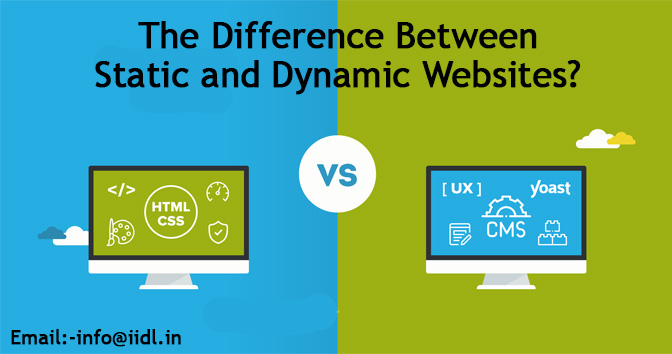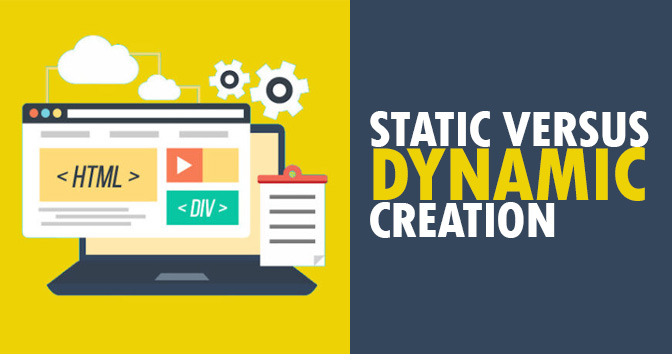


Custom web improvement has progressed significantly. At first, websites were basic site pages that showed data without offering a lot of usefulness in any case. Presently, we have websites that can cooperate with clients on various and fluctuated levels.
Nonetheless, probably the most significant change to have occurred in site planning is the development of dynamic websites. Here we will understand the difference between static and dynamic websites.
In the least difficult of terms, a static site is one in which the substance can’t be changed without a site engineer altering its basic source code. For the most part, static locales are written in plain HTML and contain a fixed number of pages that convey data to the client.
Every guest to a static site sees precisely the same content and sight and sound each time he visits it until the site’s source code is adjusted. Websites that solitary need to show some pre-characterized data, like most websites for schools and associations, are by and large static and dynamic websites different.
Then again, dynamic websites can show changed substance from a similar source code with types of dynamic websites. Dynamic websites use worker-side programming like PHP, ASP.NET, or JSP to change content as indicated by continuous utilization.
By utilizing a responsive website composition, these sorts of websites are equipped for showing differed content contingent upon the client’s boundaries, similar to their constant information sources and which working framework or stage they are utilizing.
Some genuine instances of dynamic websites are web-based business websites like Amazon and long-range interpersonal communication websites like Facebook. Here we will understand the difference between static and dynamic websites is.
Websites arrive in a wide range of shapes and sizes; however, one way they can be isolated is between fixed destinations and vibrant locales. The difference isn’t clear when you’re simply taking a gander at a site in your program, yet it’s anything but a significant difference in the capacity of your site.
Static websites



A static site comprises a progression of HTML records, everyone addressing an actual page of a site. So on static locales, each page is a different HTML document. At the point when you visit the landing page, you see the actual landing page document.
Static Web pages are exceptionally straightforward. It is written in dialects like HTML, JavaScript, CSS, and so on. For static site pages, when a worker gets a solicitation for a site page, then, at that point, the worker sends the reaction to the customer without doing any extra cycle.
Also, these pages are seen through an internet browser. In static pages, Pages will continue as before until somebody transforms it physically.
Regardless of whether two pages contain a piece of indistinguishable substance (like a footer), the two of them include two forms.
Along these lines, on the off chance that you need to refresh the footer, you should do so twice, once on each page. This is genuinely clear, and it’s how all websites were worked during the early long periods of the internet.
Also Read this – Freelance Digital Marketing Jobs: 5 Benefits Of Being A Freelancer
Dynamic Websites



A dynamic site utilizes worker advances (like PHP) to dynamically fabricate a site page when a client visits the page. Fundamentally, what happens is the client goes to a specific web address, and the worker discovers a lot of various snippets of data that it’s anything but a solitary firm site page, which is the thing that you see.
Dynamic Web Pages are written in dialects like CGI, AJAX, ASP, ASP.NET, etc. In dynamic website pages, the Content of pages is diverse for various guests. It requires more investment to stack than the static website page.
Dynamic site pages are utilized where the data is changed habitually, for instance, stock costs, climate data, and so forth. This method of building website pages “on the fly” enjoys a few benefits.
The advantages of dynamic and static websites



1.Simpler plan refreshes
Since each piece of a website page is independent, it is a lot less challenging to refresh something across numerous pages at the same time; for instance, on the off chance that you have a change to your site’s route, you need to transform it in one spot (the record that holds route data).
It is refreshed on all pages that contain that document. If you had a static site, you would need to alter every page to roll out an improvement to the site’s route. This is dreary, redundant, and inclined to mistakes.
2.More adaptable information
Since a dynamic site arranges many page pieces to make an entire page, you can store your substance (and different pieces of your site) in a data set.
The upside of this is that you can undoubtedly get to and alter your meaning in various ways or even have it load across different websites (for instance, you had two particular brands with some covering content on the off chance.)
Likewise, data sets make it simple to look through your substance, arrange it, load it dynamically (for example, showing the five latest passages about sock manikins), and back it up. The entirety of this is almost incomprehensible with a static site.
3.Simpler substance refreshes
Dynamic websites with a substance the executive’s framework (CMS) simplify it’s anything but a non-specialized individual to make and refresh the web page’s importance.
Since the different page pieces are generally discrete, a substance designer will not have to know any HTML to make another page or article for the site.
You can focus on composing the substance, and the dynamic webpage deals with placing that substance into the right on the money the site.
With a static website, the substance designer would need to know HTML or utilize somebody who does to make another website page for a website.
Also Read this – Earning Money by Participating in Logo and Website Design Competitions
Static versus Dynamic Creation



Static Web pages show absolutely something very similar whenever anyone visits them. Static Web pages shouldn’t be a plain natural substance. The static site page is a site that is made thoroughly using HTML. Each page is an alternate chronicle, and there are no data sets or external records drawn upon.
This infers the ideal approach to adjust this sort of site is to go into each page and modify the HTML. So you would have to do it without anybody’s assistance using a website page director, for instance, FrontPage or Dreamweaver, or pay your website specialist to make updates for you.
They can incorporate organized blended-media plans and even chronicles. Regardless, every guest to that page will be invited by the same sight and sound setup or video each time he/she visits the page until you change that page’s source code.
Dynamic Web pages are good for making various substances for different organizations from a similar source code record. An active Web page isn’t as an issue, obviously, better than a static Web page.
The two essentially fill assorted necessities. The site can show different substances considering what working system or program the visitor is utilizing, regardless of whether he/she is using a PC or a PDA, and the reason that referenced the guest.
Designers generally make static pages with HTML yet use lingos like PHP, Javascript, or Action content to produce dynamic pages. They can, in like manner, use frameworks like Ruby on Rails, Django, or Flex for component pages.
Dynamic vernaculars and frameworks moreover have the individual capacity to make static Web page content. Regardless, doing as such makes source code senselessly capricious for its inspiration while being more enthusiastic about keeping up.
Dynamic pages can fill a combination of necessities. For example, locales continue to run by substance organization structures license a particular source code report to stack the substance of a broad scope of possible pages.
Content creators use an entryway page to introduce the material for new locales into the importance of the executive’s framework’s data set.
The dynamic contact would then be able to stack the material for any page in the data set, considering boundaries in the URL with which a visitor requests the page. Dynamic pages are moreover what allowed customers to sign into locales to see redid content.
Various people favor dynamic destinations since they have a lot of benefits. Dynamic areas decline ongoing help costs, make data organization very compelling, and enable future additional items, such as data support or a general site look. They similarly make it hard to wreck the organization, as might occur if you modify anything but a site page supervisor.



